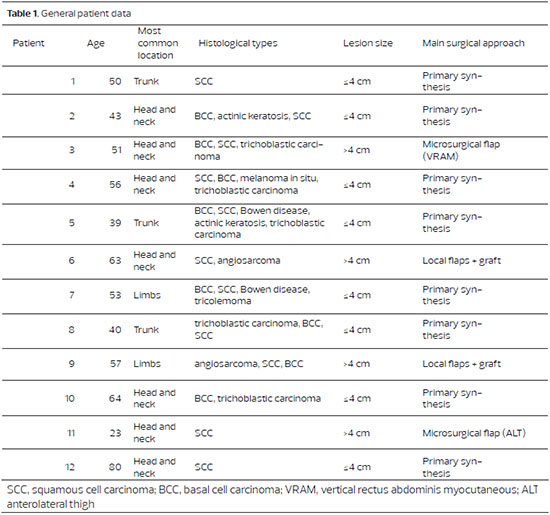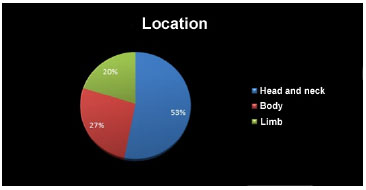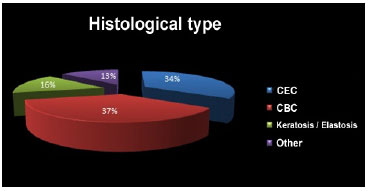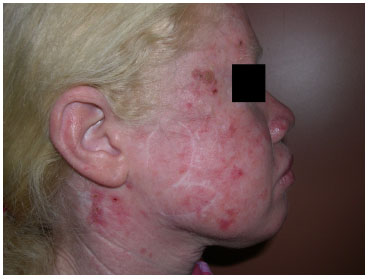ABSTRACT
INTRODUCTION: To describe a case series involving albinos as to the form, location, treatment and monitoring of skin tumors.
METHODS: A descriptive, retrospective from April to July 2011, analyzing a total of twelve charts. Seeking the histopathologic results, and descriptions of surgical procedures, collect and report specific data.
RESULTS: Twelve patients had albinos and 273 injuries were studied. Eight men and 4 women, aged between 23 and 80 years, the majority being over 40 years old (92%). The most common injuries were to the head and neck being the most common histological type BCC (36.63%), followed by the CEC. Some injuries were also found tricoblástico carcinoma, high-grade sarcoma, verruca vulgaris, melanoma in situ and Bowen's disease. On average, patients were followed for 98.6 months. Among the surgical procedures the most common was the realization of primary synthesis (82.41%) and second flaps, two microsurgical (VRAM and RALC). The sizes of the lesions was divided into equal or lower than 4 cm (80.20%) and higher than 4 cm (19.80%).
CONCLUSION: Using a short data aggregation was possible to describe a sample with similar data exposed in the international literature, despite the lack of them, allowing a comparison and demonstration about the relationship between albinism and skin tumors, but new series with more patients are needed to better overall evaluation. So prevention remains the best way of monitoring and follow-up of patients with albinism.
Keywords:
Albinism; Therapeutics; Carcinoma Basal Cell; Carcinoma Squamous Cel.
RESUMO
INTRODUÇÃO: Descrever a casuística envolvendo albinos, quanto à forma de apresentação, local, tratamento e acompanhamento dos tumores de pele.
MÉTODOS: Estudo descritivo, retrospectivo, de Abril à Julho de 2011, analisando um total de doze prontuários. Buscando nos resultados histopatológicos, e nas descrições dos procedimentos cirúrgicos, reunir e reportar dados específicos.
RESULTADOS: Doze pacientes albinos apresentaram 273 lesões e foram estudados. Oito homens e 4 mulheres, com idades variando entre 23 e 80 anos, sendo a maioria acima de 40 anos (92%). A localização mais comum das lesões foi na cabeça e pescoço, sendo o tipo histológico mais frequente o CBC (Carcinoma Basocelular) (36,63%), seguido do CEC. Algumas lesões também encontradas foram carcinoma tricoblástico, sarcoma de alto grau, verruga vulgar, melanoma in situ e Doença de Bowen. Em média os pacientes foram acompanhados, por 98,6 meses. Dentre os procedimentos cirúrgicos realizados o mais comum foi à realização de síntese primária (82,41%) e em segundo lugar os retalhos, sendo dois microcirúrgicos (VRAM e RALC). Os tamanhos das lesões foram divididos em menores ou iguais a 4 cm (80,20%) e maiores do que 4 cm (19,80%).
CONCLUSÃO: Através de uma breve agregação de dados foi possível descrever uma casuística com dados semelhantes aos expostos na literatura internacional, apesar da escassez dos mesmos, possibilitando uma comparação e demonstração entre a relação sobre albinismo e tumores de pele, porém novas séries descritivas com mais pacientes são necessárias para melhor avaliação global. Assim a prevenção continua sendo a melhor forma de monitoramento e acompanhamento dos pacientes portadores de albinismo.
Palavras-chave:
Albinismo; Terapêutica; Carcinoma Basocelular; Carcinoma de Células Escamosas.











